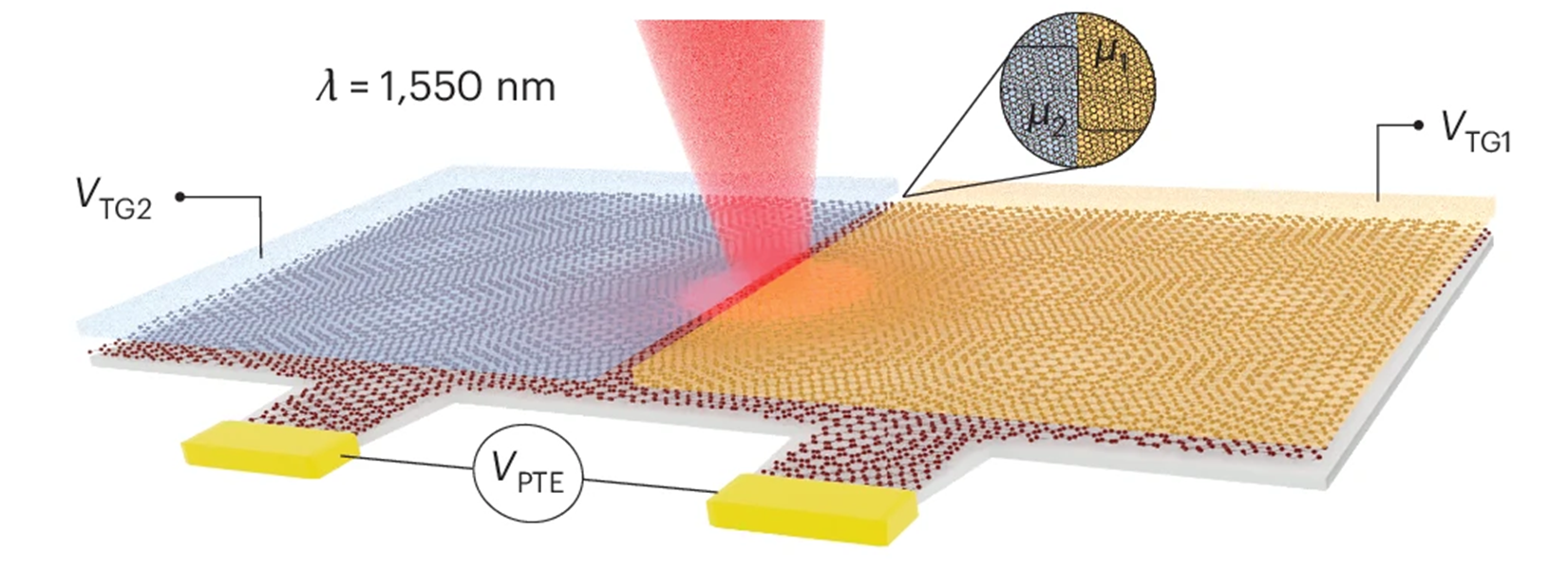Graphene’s magic twist: fast and slow electrons
Graphene, a single layer of carbon atoms arranged in a honeycomb pattern, is renowned for its ability to conduct electricity with ease. When two graphene sheets are stacked and twisted at a “magic angle” of about one degree, something remarkable happens: the electrons slow down dramatically, creating “flat bands” where they interact strongly. A new study 1 reveals that this twisted graphene, called magic-angle twisted bilayer graphene (MATBG), hosts two types of electrons: “light” ones that move quickly, like race cars, and “heavy” ones that crawl along, like heavy trucks. This unusual mix reshapes how the material handles heat and electricity, offering exciting possibilities for new technologies.
Light and heavy electrons at play
In everyday metals like copper, electrons move uniformly, their speed determined by the material’s structure. In MATBG, however, the strong interactions between electrons create a split. Light electrons zip through the material, carrying electricity efficiently, while heavy electrons, slowed by their neighbours, lumber along with a mass hundreds of times greater. This behaviour mirrors complex materials like heavy-fermion metals, where similar electron splits drive exotic properties like superconductivity. Remarkably, MATBG achieves this with just carbon atoms, making it a simple yet powerful platform for studying advanced physics.
Probing with heat, not just electricity

To uncover these electron behaviours, researchers used a clever approach. They created a tiny graphene device, about a micron wide, and used a laser to heat one part of it. As electrons moved from the hot to the cold side, they generated a voltage, a phenomenon called the Seebeck effect. This voltage reveals whether light or heavy electrons dominate the flow of heat. By adjusting the device’s electrical properties with gate voltages, the team mapped how the voltage changed with electron density and temperature, without needing physical thermometers.
Surprising findings at low temperatures
At very cold temperatures, around 10 degrees above absolute zero, the results were striking. In typical materials, the voltage flips from positive to negative as the material shifts from having more positive (hole-like) to negative (electron-like) charge carriers. In MATBG, however, the voltage stayed negative even when the material’s properties suggested it should flip. This “sign-preserving” behavior showed that light electrons dominate heat flow, while heavy electrons, despite being present, fade quickly due to their short lifetimes. This finding challenges standard theories, which assume all electrons behave similarly, and suggests a complex interplay between light and heavy carriers.
A new model for graphene’s magic
To explain these results, the researchers used a model likening MATBG to heavy-fermion systems. In this model, light electrons roam freely across the graphene layers, while heavy electrons are stuck in place, much like in materials containing rare-earth elements. Calculations based on this model matched the experimental data, showing that heavy electrons have much shorter lifetimes, allowing light electrons to control the heat flow. Even at higher temperatures, above 20 degrees above absolute zero, where ordered states break down, the voltage showed wiggles at specific electron densities, hinting that electron interactions still shape the material’s behaviour.
Why this matters
This discovery links MATBG to the physics of exotic materials, suggesting it could mimic behaviours like superconductivity or unusual magnetism in a simple, tuneable system. Practically, MATBG’s strong voltage response—50 to 150 microvolts per degree at low temperatures—rivals traditional thermoelectric materials. Since graphene absorbs light efficiently and heats its electrons quickly, MATBG could lead to sensitive infrared detectors or tiny cooling devices for quantum technologies. By controlling the material with electrical switches, scientists could create programmable thermal circuits.
The study also highlights the power of using heat to probe electron behavior, revealing details that electrical measurements miss. As researchers explore other twisted materials, like multilayer graphene or other atomically thin structures, this approach could uncover more surprises, cementing MATBG’s reputation as a “magical” material with endless possibilities.
Author: César Tomé López is a science writer and the editor of Mapping Ignorance
Disclaimer: Parts of this article may have been copied verbatim or almost verbatim from the referenced research paper/s.
References
- Rafael Luque Merino, Dumitru Călugăru, Haoyu Hu, Jaime Díez-Mérida, Andrés Díez-Carlón, Takashi Taniguchi, Kenji Watanabe, Paul Seifert, B. Andrei Bernevig & Dmitri K. Efetov (2025) Interplay between light and heavy electron bands in magic-angle twisted bilayer graphene Nature Physics doi: 10.1038/s41567-025-02912-x ↩